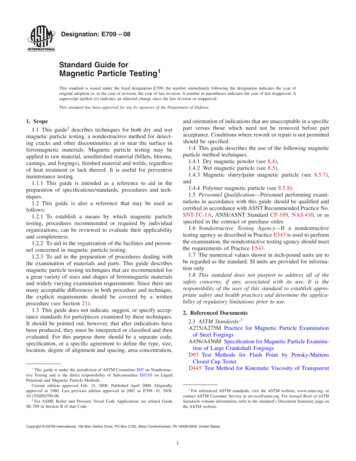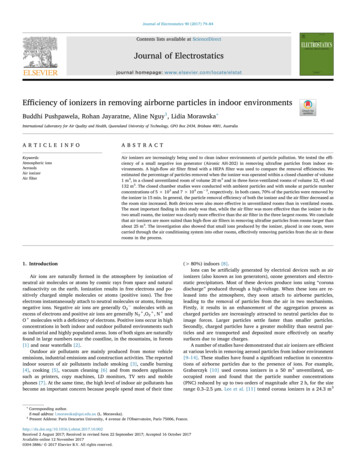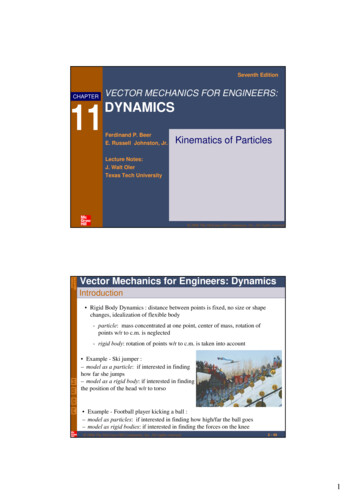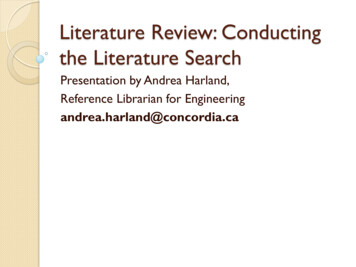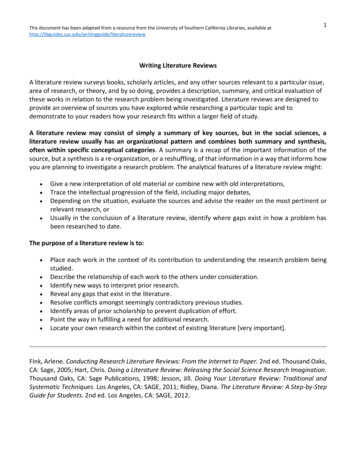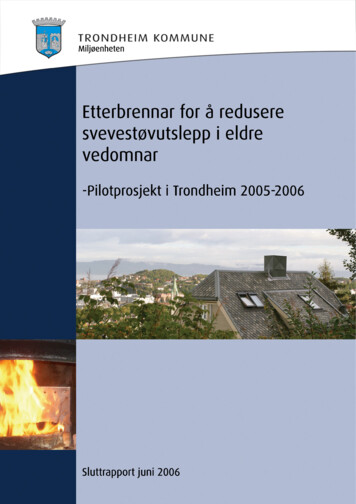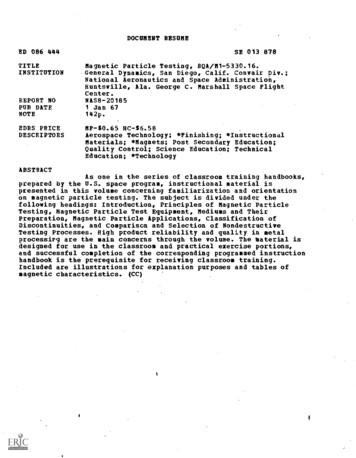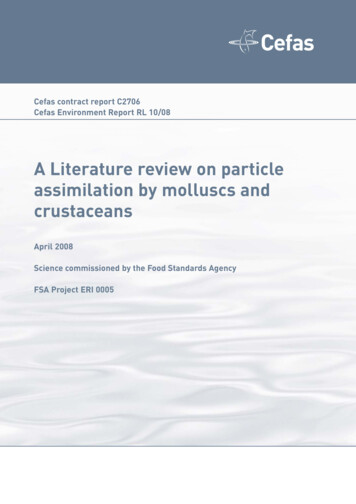
Transcription
Cefas contract report C2706Cefas Environment Report RL 10/08A Literature review on particleassimilation by molluscs andcrustaceansApril 2008Science commissioned by the Food Standards AgencyFSA Project ERI 0005
Cefas Contract C2706Environment Report RL 10/08Literature review on particle assimilation by molluscs andcrustaceansThe Centre for Environment, Fisheries and Aquaculture Science,Lowestoft LaboratoryPakefield RoadLowestoftSuffolkNR33 0HTJonathan BeechamApril 2008The work in this report was completed under contract to the EmergencyPlanning, Radiation and Incidents Division of the Food Standards AgencyFSA Contract ERI 0005Cefas Contract C2706
SummaryLiterature on the size of particles ingested by bivalves and crustaceans wasexamined. In bivalves, particles above a minimum size (from 1 to 7µmdiameter) were preferentially ingested, and particles above around 50µm wererejected because they did not fit in the groove in the Ctenidium. Inorganicparticles of any size were less likely to be accepted than digestible particles.However, examination of gut contents revealed that much larger particles thanthis, up to the order of 400µ m, were sometimes ingested and could remain inthe gut for much longer than food items, so that the risk of contaminationassociated with eating these particles would seem to be higher than their lowrate of ingestion would indicate. Bivalves became much less selective whensuspended particle concentrations were low. The prevalence of these largeparticles in the gut appears to be greatest in oysters, but this may be a bias inthe studies, since large particles were also found in cockles.There is much less information on particle selection by decapods. Many smalldecapod species and larvae apparently consumed large food items, but thesewere organic, in effect prey items, so the maximum size of inorganic particlethat may be ingested is uncertain. Given the prevalence of bivalve species inthe prey of many decapods, the limit size of particles ingested by bivalveswould constitute a lower estimate for this. Filter feeding gastropodspreferentially consume particles up to around 60µ m, although there is limitedevidence of larger particles being ingested.2
ContentsSummary .21. Introduction .42. Bivalves .53. Decapods.94. Gastropods .105. Conclusions .106. References .12Figure 1: Simplified model of filter food processing by bivalves. .5Figure 2: General pattern of size selectivity by bivalves .63
1. IntroductionA literature review was carried out for studies of ingestion in commonly eateninvertebrate species. The groups of species are listed below. The search wascarried out using Scopus (www.scopus.com) using terms related to the taxonsunder study – e.g. bivalves, gastropods, decapods – and lower levelclassifications within these under ‘titles/keywords/abstracts’. Terms searchedalongside included ‘particles’, which returned few results, ‘contaminants’ and‘feeding/ingestion’, which yielded a large number of results (around 2000) thatcould be checked by title and abstract. The primary articles were checked forreferences and citations within Scopus. The database search goes back to1960 although there were few records in the primary search due to lack ofabstracts and keywords for searching. Specific species-only searches werecarried out for important species such as Cancer pagurus (edible crab) (200records but only four of relevance). Scopus also gave references on the worldwide web, but since most of these were educational or concerned withaquarium management only a cursory examination was made of these. Thesearch revealed about 200 articles worth further examination.Both molluscs and crustaceans are consumed by humans and are obligate orfacultative filter feeders. There exists a body of knowledge on uptake ofsoluble inorganic pollutants (such as arsenic and mercury from methylmercury) e.g. Fisher et al. (1996). However the main understanding aboutuptake of particulate contaminants comes from studies primarily undertakento study feeding behaviour.The main classes of molluscs and crustaceans consumed by humans are:Bivalves (mussels, cockles, oysters, clams) – obligate filter feeders.Cephalopods (octopus, squid, cuttlefish) – these are predators and there isno information on the size of incidentally captured particles. In any case, gut isunlikely to be consumed.Gastropods (whelks, periwinkles ) – mixture of feeding modes, with somefilter feeding.Crustaceans of the order Decapoda (crab, lobster, Nephrops) – most ofwhich engage in filter or scavenging behaviour, though many crabs andlobsters are primarily predators.4
2. BivalvesThe feeding mechanism of bivalves is a process of active sorting wherebyparticles of different sizes are ingested. This process is an active one (so thatbivalves are not simply passive filter feeders) with nutritious organic preyingested and non-edible particles rejected (Owen 1974) (see Figure 1).Particles of sufficient size (typically between 1µ m and 7µ m depending onspecies, (Sobral & Widdows, 2000; Winter, 1978; Mølenberg & Riisgård,1978; Haven & Morales-Alamo, 1970)) are removed from the water byfiltration and then sorted by the palps on the labia into ingested particles andnon-ingested particles which are encased in mucus and then rejected fromthe mouthparts as pseudofaeces (Jørgensen, 1975; Levinton et al. 1996). Thelower selection limit (Figure 2) was highest for Pecten (scallops) species andsmallest for Cardium (cockles) (Hawkins et al. 1998, Beninger et al. 1999).However, this sorting is not precise and will be affected by factors such asparticle concentration. Furthermore in many cases there was little sortingbetween different kinds of organic matter (Shumway et al. 1985), and there issome debate as to the extent to which sorting is sufficiently controlled tooptimise the intake of required nutrients (Bayne 1998). Jørgensen (1996)specifically rejected sorting by food value, whilst acknowledging sorting bysize, shape and other physical attributes. Nevertheless it was observed thatconcentration of inorganic contaminants were higher in the pseudofaecesthan in the suspended particulate matter on which they fed (Allison et al.1998).Figure 1: Simplified model of filter food processing by bivalves.ExhaledWaterInflow bialPalpRejectedPseudofaeces5OesophagusGutFaeces
Mussels, mainly Mytilus edulis, are generally considered to be herbivorousfilter feeders with phytoplankton and bacteria the main part of their diet,although zooplankton may be consumed as well (Davenport et al. 2000;Rouillon & Navarro, 2003). Field (1911, see Newell et al. 1989) observed awide range of items in the gut of M. edulis, particularly diatoms anddinoflagellates. These could be 200 µ m or more in length, though weretypically elongate so usually no more than 40 µ m in diameter. A similarmaximum diameter for typical ingested particles was reported in Oysters(Crassostrea gigas) by Dupuy et al. (1999). There would seem, however, tobe a tendency for larger inorganic (SiO2) particles to be rejected withDefossez & Hawkins (1997) reporting particles of 18.7µ m and above wereincreased in relative concentration in the surrounding water – i.e. they werenot taken up. Lehane & Davenport (2002) reported a wide range of animalparts inside the guts of mussels and oysters, indicating a degree of carnivoryin species commonly assumed to be herbivorous. Widdows et al. (1979)reported that the size of food items ingested by M. edulis was typically lessthan 40µ m, with the largest sized, around 30µ m, being taken up in springand summer.Figure 2: General pattern of size selectivity by bivalves, showing positive selection forparticles above a lower limit of a few microns, which peaks for mid-sized particles, typically 2030µ m, and then falls off above 40µ m, but with a few large particles nevertheless beingingested. The absolute magnitude of selection depends on concentration, species and type estedSelectivity0.6Preferred Size0.4Negative0.2Selection0110100Particles size (micron) Log scale61000
For bivalves feeding from suspended particles when particle organic matterwas low and particle concentration was low, the feeding efficiency effectivelybecomes negative (the energetic costs of feeding, including selection, exceedthe nutritional benefits of the food ingested) (Velasco & Navarro 2002). Inthese conditions bivalves tend to reduce their active sorting of particles(Deslous-Paoli et al. 1992, Raillard et al. 1993). For Mytilus edulis thisthreshold is about 5mg l-1 (Widdows et al. 1979). This only refers to Seston(particles suspended in fluid) feeders, so that bottom feeders will to someextent always be selective.Cockles (Cerastoderma edule) were shown to ingest particles in the range 2 –12 µ m with preference for the larger particles – there were, however, noparticles above 12µ m in the sediment (Iglesias et al. 1992). On the otherhand, Karlsson et al. (2003) observed uptake of large organic particles(cellulose) of 60 to 500µ m. This was under controlled conditions when theavailability of such large particles had been artificially increased, although thesame authors also noted sand grains of up to 600µ m in the cockles’intestines.Scallops (Placopecten magellanicus) were capable of extracting particles upto 40 µ m from a variety of sediment and debris types (Cranford & Grant,1990). It was noted that size selectivity was highly variable betweenindividuals, with selection for or against larger organic particles of sizes up to72 µ m (MacDonald & Ward, 1994). However, the majority of particles in thisstudy were in the range 2 – 12 µ m.Scallops also showed a difference in the post-ingestive processing ofinorganic versus organic components with inorganic (polystyrene beadscoated with 51Cr ) being retained longer in the stomach (Brilliant & MacDonald2002), potentially leading to an increased duration of time for which theshellfish remain contaminated after ingestion of radioactive particles. Theretention time of larger organic particles is also longer (Brilliant & MacDonald2000).The clearance rate of particles by scallops has been shown to be dependenton the organic matter concentration as well as the size of the inorganicparticles – clearance rates reach their theoretical maximum at around 20µ mor above for inorganic particle size, suggesting a reduced uptake of particlesabove this size in scallops (Brilliant & MacDonald 2000). Similarly, StentonDozey & Brown (1992) reported that clams (Venerupis corrugatus) clearedparticle sizes of between 8 – 13 µ m most efficiently, but this was from a poolwhere the maximum recorded particle size was 23µ m, so no large particleswere present.Clams of the genus Potamocorbula would ingest polystyrene particles of44µ m (Penry 2000), providing their concentration was sufficiently low to avoidrejection. It was hypothesised that inert particles of this size would pass fromstomach to intestine and not into the digestive gland. If it were to do so, itwould be liable to become stuck impeding further digestion of other particles.7
The clams seemed capable of passing these particles and it was not knownhow often such a large particle could become stuck in the body, althoughthere was evidence that this happened. Polystyrene beads of 20 µ m werefound in the digestive glands of scallops (Placopecten magellanicus) followingfeeding. Ingestion of plastic spheres seemed to be reduced at the point offaeces production in zebra mussels, indicative that they were learning todifferentiate indigestible material (Lei et al. 1996)Observations on stomach contents of larvae of three bivalve species –mussels, scallops and clams (Raby et al. 1997) again indicated food items inthe range 5 up to 25 µ m, together with a few 25 µ m up to 40µ m indiameter. The largest size classes taken were dominated by dinoflagellates,and the uptake of these larger food items was greater for mussels than forclams when the bivalve larvae were large, and equal for smaller larvae.Tamburri & Zimmer-Faust (1996) reported the ingestion of inert particles byOysters (Crassostrea virginica). Particles up to 400µ m were ingested, andthere was no significant difference between light (polystyrene) and heavy(glass) particles – but ingestion percentage declined with particle size, withonly 20% of 275µ m particles ingested. Examination of gut contents alsoshowed large particles of up to 300 µ m were found in oyster stomachs andmay have had a role in food grinding (Bernard 1974).Cognie et al. (2003) also reported the acceptance of large food items of over150µ m in all dimensions, despite being larger than the 75µ m of the principalfilament – the selection site was therefore assumed to be the labial pulps.Baldwin & Newell (1995) reported that oyster (Crassostrea virginica) larvaecommonly consumed prey up to 12µ m in diameter but could extend this toparticles of up to 30µ m in certain conditions where large food items werepredominant. Barille et al. (1997) reported that 95% of particles ingested byCrassostrea gigas were in the range 2 – 20 µ m, although this result reflectedthe distribution of particles sizes in the seston. The preferred food size ofChilean oysters (Ostrea chilensis) was from 20µ m to 75µ m, typical of thesize of their microplankton prey (Dunphy et al. 2006). In oyster larvae, bycontrast, particle sizes 10 µ m were preferred (Fritz et al. 1984, Wilson1980), although Mackie (1968) found older oyster larvae selected food itemsof up to 30µ m diameter.It can be concluded that the main constraints on the size of ingested particlesizes in bivalves are behavioural – the active seeking out of suitable food,rather than physical – larger particles of 50µ m and above can be ingestedand processed. The size of particles ingested by Oysters is generally thelargest recorded, with sizes of up to 400µ m, although there is limitedevidence of larger particles being ingested by cockles (up to 600µ m). Largeinorganic particles of around 40 – 50 µ m are ingested when the concentrationof organic matter is low to avoid the costs of active particle filtration.It should also be noted that the conclusions of size ingestion in many studiesare limited by the material with which the bivalves were presented. For8
example, in a survey conducted by Ward & Shumway (2004) of 43 studies ofpreingestive selection, only three used particles that exceeded 40µ m.3. DecapodsThere is generally less information about decapod crustaceans. In additionmany decapod species are primarily predators so that particle ingestion maybe incidental to feeding behaviour and consequently not explicitly studied. Themost commercially significant species are primarily consumers of bivalves(Lake et al. 1987, Mascaró & Seed 2001). Larvae of the larger decapods tendto be filter feeders and so some studies have been carried out on these.Hinz et al. (2001) noted that plastic beads tended not to be ingested by crablarvae, unless they were associated with Prorocentrum micans (ratio 1 part in20 Prorocentrum) – otherwise around 5% of the beads presented were takenup. Shaber & Sulkin (2007) also noted the tendency for larval crabs to take updinoflagellates of approximately 40µ m in size.The antennal collectors of small suspension feeding crabs (Emerita talpoida )were able to pick up particles of 25µ m (Canova, 1999) but this study gave noindication of likelihood of acceptance of inert particles.Larval crabs of Hemigrapus oregonensis survived only with prey of largersizes (Prorocentrum micans 75µ m and Artemisia 300µ m and above) (Lehtoet al. 1998). These results were indicative of a carnivorous diet althoughsmaller particles, such as algae of size approximately 10µ m were taken alongwith detritus. These experiments did not really reveal the selectivity of thecrab larvae to larger inorganic components. Tropical mud crab larvae readilytook up microbial bound particles of up to 400µ m in the largest larval stages(Genodepa et al. 2004), but this species is unlikely to be found in UK waters.Sand Crabs, Emerita analoga, showed a small increase in ingestion ratewhen presented with a supply of 62µ m glass beads; they also accepted fooditems, Artemia, of 150 µ m (Efford, 1971).Examination of the presence of plutonium in Cancer pagurus indicated thatradioactive contaminants passed across the gills but were not taken up intothe edible parts of the crab (Guary et al. 1976).Shrimps of the order Thalassinidae (Pinn et al. 1998), potential prey for largerdecapods, were shown to select against particles larger than about 10µ m intwo species of genus Upogebia, but there was no significant selection in threeother species, indicating that particles of more than 50µ m could be ingested.On the other hand Stamhuis et al. (1998) suggest that 30µ m is potentially thelargest size of particle capable of being trapped by the maxillipeds. Hunt(1992) suggests that larger particles than this are directly pushed in by themouthparts. Ghost shrimps Biffarius arenosus and Tryaea australiensistended to reject particles 63 µ m in diameter with B. arenosus preferring9
particles 15.6 µ m (Stapleton et al. 2002). Brine shrimps (Artemia) had apreferred particle size of around 16µ m and did not ingest particles larger than50µ m (Fernández, 2001). Examination of ingestability and weight gain ofparticle feeds in shrimps (Obaldo et al. 1998) revealed that they had difficultyin ingesting particles sizes above 124µ m.4. GastropodsA number of gastropod species are deposit feeding (Kamimura & Tsuchiya,2004), primarily consuming various microbes such as microalgae and aquestionable amount of detritus (Levinton et al. 1984). Mud snails (Hydrobiatotteni) showed a preference for particles between 41 and 63 µ m (Levinton &DeWitt, 1989), including glass beads, but larger particles over 100µ m weretaken. There was considerable variation in particle choice depending onparticles available in the substrate. Whitlatch & Obrebski (1980) reported thatdeposit-feeding gastropods fed on diatoms ranging in size up to 36µ m, withpreferred size varying with the size of the predator.5. ConclusionsParticle acceptance and rejection is a process of active sorting not passivefiltration. It has been observed that even within the species of organic matter,there will be selection for a preferred food over a less favoured one and thatthis has something to do with taste or nutritive value more than size (althoughsize is an issue). Because of this taste effect it is not straightforward toevaluate the risk of novel particle ingestion, although the most reasonableassumption is that radioactive particles are similar to other dense inorganicparticles, for example silicates, with regard to their uptake.Overall, there is evidence of preferential uptake in mollusc species of particlesof 50µ m, but inorganic particles of this size are not taken up often. However,the general observation from a variety of bivalve and gastropod species is thatlarger particles, organic and inorganic, are occasionally taken up, even thoughthey are not actively selected. Bivalves and gastropods seem to be capable ofingesting particles in excess of 100µ m. There is strong evidence for uptake ofsuch large particles in oysters, but even mussels and cockles have beenobserved to contain large particles, up to a maximum of 600µ m. Furthermorethese larger particles may be less readily excreted than particles in the sizerange of normal food.Other common invertebrate species – Nephrops norvegicus, Cancer pagurusand Cephalopod species are primarily carnivorous. Typical prey sizes for crablarvae are variable, but are typically up to 300µ m. For adults prey items maybe large and include bivalves and crustaceans. The substantive question isthe extent to which there may be incidental uptake of inorganic particles.10
In conclusion, particle sizes up to 50µ m are liable to be consumed bycommonly eaten mollusc species. However this consumption will not bepreferential and so the risk will be lower (by a factor of 5-10) than theprobability indicated by comparing numbers of contaminant particles than foodparticles in this size range. There is also a risk of ingestion of larger particlesin the range 300 – 600 µ m. This risk is impossible to assess from ingestionstudies as ingestion of particles in this range is rare and seldom studied.However, examination of gut contents reveals that this does happen,especially in Oysters (but also observed in cockles and probably in otherspecies). The risk of these particles is that they may be retained for a longtime – and may be beneficial to the organisms by aiding digestion. Noevidence was found of particles above 600µ m in diameter being ingested.For crustaceans the position is less clear, although the figures given forbivalves would serve as a first estimate. Although many crustaceans,particularly crab species, do take larger food items, it would seem that this isin response to specific prey – which would have had to ingest a contaminatedparticle first of all.There is a deficiency of data for many species, especially decapods andgastropods. Gastropods, in particular, may be a significant component of localdiet even though they are not major food items for the UK population as awhole. Furthermore there is little information on the risks associated withsecondary consumption by commonly eaten predator species such as ediblecrabs (Cancer pagurus) that would indicate the largest inorganic particle sizesthat may be consumed by such species. Furthermore the risk fromconsumption of such species would be moderated by the likelihood of humanconsumption of the parts of the animal most likely to contain contaminants,especially the gut. Even for those species where the pattern of contaminationand retention is clearer, notably the various bivalve species studied, theremust be caution in interpretation in that most of the studies have beendirected at typical consumption for food intake studies and not at abnormalparticle intake. There is a need, therefore, to carry out experimental studieson the kinds of particles absorbed using experimental designs similar to thosereferred to in this report, but incorporating metallic particles of a range ofsizes. The studies could be extended by looking at the long-term absorption ofmetallic particles (which would not need to be radioactive) in an aquariumsystem designed to be as natural as possible.In the absence of specific experimental evidence on the uptake of largeparticles in different species we would make a general recommendation thatthe possibility of ingestion of particles of sizes up to 1mm should be taken intoaccount in risk assessment (that is allowing a safety margin above the 600µm,which is the largest size recorded). This would seem to apply to all species ofbivalves, which recorded similar maximum particle sizes, even though the sizeof preferred particles varies. For other species, there is no evidence ofgeneral intake of larger particle sizes although the degree of uncertainty ishigher, so that the 1mm rule would seem to be an appropriate one.11
6. ReferencesAllison N, Millward GE, Jones MB. Particle processing by Mytilus edulis:Effects on bioavailability of metals. Journal of Experimental Marine Biologyand Ecology. 1998; 222(1-2):149-62.Baldwin BS, Newell RI. Relative importance of different size food particles inthe natural diet of oyster larvae (Crassostrea virginica). Marine EcologyProgress Series. 1995; 120(1-3):135-46.Barillé L, Prou J, Héral M, Razet D. Effects of high natural sestonconcentrations on the feeding, selection, and absorption of the oysterCrassostrea gigas (Thunberg). Journal of Experimental Marine Biology andEcology. 1997; 212(2):149-72.Bayne BL. The physiology of suspension feeding by bivalve molluscs: Anintroduction to the Plymouth 'TROPHEE' workshop. Journal of ExperimentalMarine Biology and Ecology. 1998; 219(1-2):1-19.Beninger PG, Veniot A, Poussart Y. Principles of pseudofeces rejection on thebivalve mantle: Integration in particle processing. Marine Ecology ProgressSeries. 1999; 178:259-69.Bernard FR. Particle sorting and labial palp function in the pacific oysterCrassostrea gigas (Thunberg, 1795). Biological Bulletin. 1974; 146(1):1-10.Brilliant MGS, MacDonald BA. Postingestive selection in the sea scallop,Placopecten magellanicus (Gmelin): The role of particle size and density.Journal of Experimental Marine Biology and Ecology. 2000; 253(2):211-27.Brilliant MGS, MacDonald BA. Postingestive selection in the sea scallop(Placopecten magellanicus) on the basis of chemical properties of particles.Marine Biology. 2002; 141(3):457-65.Canova S. Role of particle wettability in capture by a suspension-feeding crab(Emerita talpoda). Marine Biology. 1999; 133:419-428.Cognie B, Barillé L, Massé G, Beninger PG. Selection and processing of largesuspended algae in the oyster Crassostrea gigas. Marine Ecology ProgressSeries. 2003; 250:145-52.Cranford PJ, Grant J. Particle clearance and absorption of phytoplankton anddetritus by the sea scallop Placopecten magellanicus (Gmelin). Journal ofExperimental Marine Biology and Ecology. 1990; 137(2):105-21.Davenport J, Smith RJJW, Packer M. Mussels Mytilus edulis: Significantconsumers and destroyers of mesozooplankton. Marine Ecology ProgressSeries. 2000; 198:131-7.12
Defossez J-, Hawkins AJS. Selective feeding in shellfish: Size-dependentrejection of large particles within pseudofaeces from Mytilus edulis, Ruditapesphilippinarum and Tapes decussatus. Marine Biology. 1997; 129(1):139-47.Deslous-Paoli JM, Lannou AM, Geairon P, Bougrier S, Raillard O, Héral, M.Effects of the feeding behaviour of Crassostrea gigas (bivalve mollusks) onbiosedimentation of natural particulate matter. Hydrobiologica. 1992; 231:8591.Dunphy BJ, Hall JA, Jeffs AG, Wells RMG. Selective particle feeding by theChilean oyster, Ostrea chilensis; implications for nursery culture andbroodstock conditioning. Aquaculture. 2006; 261(2):594-602.Dupuy C, LeGall S, Hartmann HJ, Bréret M. Retention of ciliates andflagellates by the oyster Crassostrea gigas in French Atlantic coastal ponds:Protists as a trophic link between bacterioplankton and benthic suspensionfeeders. Marine Ecology Progress Series. 1999; 177:165-75.Efford IE. Feeding in the sand crab, Ermita analoga (Stimpson) (Decaposa,Anomura). Crustaceanea 1971; 10:167-182.Fernández RG, Artemia Bioencapsualtion. Effect of particle sizes on thefiltering behaviour of Artemia franciscana. Journal of Crustacean Biology.2001; 21(2):435-442.Field IA The food value of sea mussels. Bulletin U.S. Bureau Fisheries. 1911;29:85-128.Fisher NS, Teyssié J-, Fowler SW, Wang W-. Accumulation and retention ofmetals in mussels from food and water: A comparison under field andlaboratory conditions. Environmental Science and Technology. 1996;30(11):3232-42.Fritz LW, Lutz RA, Foote MA, VanDover CL, Ewart JW. Selective feeding andgrazing rates of oyster (Crassostrea virginica) larvae on natural phytoplanktonassemblages. Estuaries. 1984; 7(4 B):513-8.Genodepa J, Southgate PC, Zeng C. Diet particle size preference and optimalration for mud crab, Scylla serrata, larvae fed microbound diets. Aquaculture.2004; 230(1-4):493-505.Guary JC, Masson M, Fraizier A. In situ preliminary study of plutoniumdistribution in different tissues and organs of Cancer pagurus (Crustacea:Decapoda) and pleuronectes platessa (Pisces: Pleuronectidae). MarineBiology. 1976; 36(1): 13-17.Haven DS, Morales-Alamo, R. Filtration of particles from suspension by theAmerican oyster Crassostrea virginica Biological Bulletin. 1970; 139:248-264.13
Hawkins AJS, Smith RFM, Tan SH, Yasin, ZB. Suspension-feeding behaviourin tropical bivalve mollusks: Perna viridis, Crassostrea belcheri, Crassostreairadelei, Saccostrea cuccalata and Pinctada margarifera. Marine EcologyProgress Series. 1998; 166:173-185.Hinz S, Sulkin S, Strom S, Testermann J. Discrimination in ingestion ofprotistan prey by larval crabs. Marine Ecology Progress Series. 2001;222:155-162.Hunt MJ. Feeding by penaeid prawns: The role of the anterior mouthparts.Journal of Experimental Marine Biology and Ecology. 1992; 160(1):33-46.Iglesias JIP, Navarro E, Alvarez Jorna P, Armentia I. Feeding, particleselection and absorption in cockles Cerastoderma edule (L.) exposed tovariable conditions of food concentration and quality. Journal of ExperimentalMarine Biology and Ecology. 1992; 162(2):177-198.Jørgensen CB. Comparative Physiology of suspension feeding. AnnualReview of Physiology 1975; 37:57-79.Jørgensen CB. Bivalve filter feeding revisited. Marine Ecology ProgressSeries. 1996; 142(1-3):287-302.Kamimura S, Tsuchiya M. The effect of feeding behavior of the gastropodsBatillaria zonalis and Cerithideopsilla cingulata on their ambient environment.Marine Biology. 2004; 144(4):705-12.Karlsson O, Jonsson PR, Larsson AI. Do large seston particles contribute tothe diet of the bivalve Cerastoderma edule? Marine Ecology Progress Series.2003; 261:161-73.Lake NCH, Jones MB, Paul JD. Crab predation on scallop (Pecten maximus)and its implication for scallop cultivation. Journal of the marine BiologicalAssociation of the
wide web, but since most of these were educational or concerned with aquarium management only a cursory examination was made of these. The search revealed about 200 articles worth further examination. Both molluscs and crustaceans are consumed by humans and are obligate or facultative filter feeders. There exists a body of knowledge on uptake of
